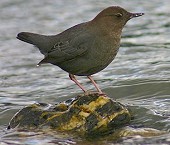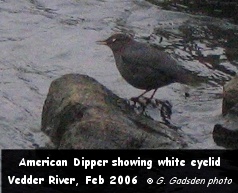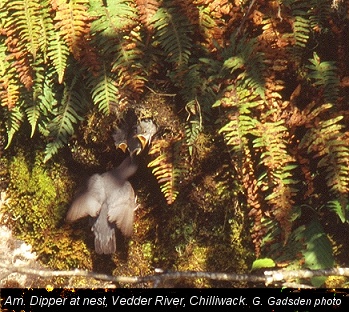The American Dipper
By Gord Gadsden
March 2007
The American dipper is a fairly common sight on our local streams and small rivers, especially in the  Upper Fraser Valley. They are often seen flying by, noisily chasing other dippers, or happily splashing around in frigidly cold water. Upper Fraser Valley. They are often seen flying by, noisily chasing other dippers, or happily splashing around in frigidly cold water.
American dippers belong in the perching bird family along with robins, sparrows and crows. Worldwide, there are six species of dipper. These species are found in South America, Aisa, Europe and, our one species, in North America. The American dipper can be found from Alaska south to Panama. They are year round residents in southern B.C., but will move location depending on food availability and to avoid excessively cold weather.
The dipper is well adapted to their unique streamside life. Their main food source is aquatic insects such as caddis fly larvae but, depending on abundance, small fish and drifting salmon eggs are also eaten. They have several methods to capture their food. They will swim through both pools and rapids alike with their heads underwater searching for prey, dive to depths of up to 20 feet and they can even walk on a river's bottom with water too swift for a person to stand in. The dipper's physical characteristics are the key to its success. Their bodies are tightly packed with soft feathers that do not saturate with water easily. Water is further repelled by oil preened into the feathers from the bird's oil gland. Their wings are short and powerful to enable them to 'fly' through the water. Their eyes and nostrils also have modifications. A clear-white nictitating membrane (third eyelid) covers the eyes and special scales close the nostrils when they are underwater. You can sometimes see them blinking this white eye membrane when a dipper lands close enough to you. eaten. They have several methods to capture their food. They will swim through both pools and rapids alike with their heads underwater searching for prey, dive to depths of up to 20 feet and they can even walk on a river's bottom with water too swift for a person to stand in. The dipper's physical characteristics are the key to its success. Their bodies are tightly packed with soft feathers that do not saturate with water easily. Water is further repelled by oil preened into the feathers from the bird's oil gland. Their wings are short and powerful to enable them to 'fly' through the water. Their eyes and nostrils also have modifications. A clear-white nictitating membrane (third eyelid) covers the eyes and special scales close the nostrils when they are underwater. You can sometimes see them blinking this white eye membrane when a dipper lands close enough to you.
American dippers breed in early summer having two but sometimes even three broods. They make a nest, shaped much like a hut, out  of moss and suspend it on the side of a midstream boulder or riverbank and often under bridges. With river level fluctuation and the risk of losing a nest common, having two broods in a year helps guarantee at least one successful nest. Four to six white eggs are laid per clutch and they hatch in 13 - 17 days. While the young from the first nest are still in the nest and getting close to flying, the female will start a new nest nearby. The male will feed the young from the first nest until, and for a while after, the young leave the nest. The male, along with the female, will also help feed the young from the second nest once they hatch. Young dippers can fly anytime after 18 days of age. Dippers are also polygynous, often trading partners halfway through a breeding season. of moss and suspend it on the side of a midstream boulder or riverbank and often under bridges. With river level fluctuation and the risk of losing a nest common, having two broods in a year helps guarantee at least one successful nest. Four to six white eggs are laid per clutch and they hatch in 13 - 17 days. While the young from the first nest are still in the nest and getting close to flying, the female will start a new nest nearby. The male will feed the young from the first nest until, and for a while after, the young leave the nest. The male, along with the female, will also help feed the young from the second nest once they hatch. Young dippers can fly anytime after 18 days of age. Dippers are also polygynous, often trading partners halfway through a breeding season.
No one is certain why these birds 'dip' up and down while perched. Some suggest it's for communication purposes or to perhaps improve visibility in their constantly moving environment.
A study, undertaken by a student from SFU, has been underway for the last 4 years on the Chilliwack/Vedder River. This study has included monitoring the numbers of birds and dispersal patterns via leg bands. If you see a banded dipper, record the colour codes. . Please post your sighting of banded dippers to the Fraser Valley Birding forum or email it to gordfvb@gmail.com and it will be passed on. Sightings from outside the Vedder River watershed are most desired. Currently, the furthest record of a bird banded from the Vedder River was at Cheam Lake Wetlands in Popkum where it is surmised to have possibly come over Cheam Ridge following the mountain streams.
American dippers might not only be an entertaining part of the river ecosystem for anglers to observe when fishing is slow. Since dippers depend mostly on aquatic insects, these birds can be a good way to gauge a river system's health. Aquatic insects are often the first to disappear when a river becomes polluted or otherwise unhealthy, so a lack of dippers in a system may indicate poor river health. |